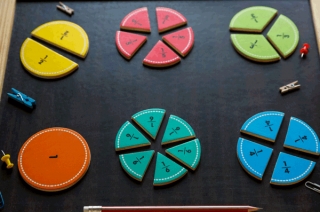
New Culinary Math Teaching Series
31 October 2022Math instructor Linda Blocker shares tips on building students’ math confidence from decimals and fractions to costing out recipes.
By Lisa Parrish, GMC Editor, and
Linda Blocker, CHE, Associate Professor SUNY Delhi
Feedback & comments: This email address is being protected from spambots. You need JavaScript enabled to view it.
Do your culinary students arrive with general math baggage? Do they have memories of so-called “real world” word problems that may be from the real world but have no connection to their world? Many of these students are done before they begin and never allow themselves to relate to the culinary math concepts that, perhaps for the first time, will make sense in their world. As their instructors, we sometimes only have one semester to help them understand the math that will support them in their careers.
Linda Blocker, associate professor in the School of Business and Hospitality Management, understands the challenges of teaching applied math. Before joining the faculty at the State University of New York at Delhi, she taught middle school and high school math. Linda found her passion for teaching applied math when she began teaching at the Culinary Institute of America. It was her time at the CIA that changed her understanding of how to support students as they discover that they can be successful and understand math concepts. Her unique teaching experiences have taught her a thing or two about the best way to reach culinary students and increase their success in the fear-filled subject of math.
Blocker will help demystify math and provide practical teaching tips over the next several Gold Medal Classroom editions. Follow each article and learn how she teaches applied math problems involving fractions, decimals and percentages, as well as unit conversion and basic calculations for recipe costing.
********************************************************************
Converting fractions, decimals and percent using a food cost form example
Determining food cost is a skill our students must develop. The food cost form you use may be different than the excerpt below. However, regardless of the specific form you use, a student’s weak math skills can make the necessary calculations very difficult. I am going to address the common math errors students make with instructions on how to correct them. We have to help them use their familiarity with the ingredients and understanding of money to show that the math should make sense to them.
| Ingredient | Recipe Quantity (EP) | Cost | Extended Cost | ||
| Weight, Volume, or Count | APC/Unit | Yield % | EPC/Unit | ||
| Garlic, minced (I bulb = 2 oz.) (1 c = 4.8 oz.) |
1/8 cup | $0.50/bulb | 83% | ||
• Converting 1/8 cup to decimal for calculation
Teaching tip: The correct way to change this fraction (or any) into a decimal is to divide the numerator (1) by the denominator (8). I often tell students to always put the numerator into the calculator first. This is a common fraction in the culinary world, so students will become familiar with this fraction to decimal conversion and remember it.
Answer: 0.125
• Convert volume (1/8 cup) to weight (ounces) – multiplying decimals
Teaching tip: I teach unit conversion by demonstrating the bridge method (dimensional analysis). This method is particularly helpful for students who do not know whether to multiply 0.125 cups by the given weight, in ounces, of one cup of minced garlic. The other frustrating mistake students make is to presume that anything in a cup weighs 8 oz. This particular topic is worthy of a whole article! In fact, maybe I will do that!
Answer: 0.125 c/1 x 4.8 oz./1 c = 0.6 oz.
• Finding the price per ounce – substitution and division
Teaching tip: I teach students while math can be forgiving when we use the given weight per bulb information, the bulb is an As Purchased Quantity, not Edible Portion Quantity, and should be used with the As Purchased Cost for the most relevant and correct information. My favorite way to help students know what to do is to tell them to treat this like basic algebra substitution. It is important to mention that keeping the units attached to the numbers as students complete the calculations is very important. I liken it to needing street signs. They help us know where we are, and without them, it is easy to get lost!
Answer: $0.50/ bulb 2 oz. = $0.25/ oz
Convert percent to decimal to calculate Edible Portion Cost
Teaching tip: Students have a difficult time understanding that a percent must be converted to a decimal number when it is used in a calculation, such as calculating the Edible Portion Cost. Fraction and decimal percentages (such as 83 ¾ % or 83.75%) often make students think the steps to change a number from percent to decimal vary. This is when I tell them one of my favorite parts of math – the consistency of the procedures. The steps for converting from a percent to a decimal number are always THE SAME!! You ALWAYS divide the percent by 100 to change it to a decimal number!
Answer: 83% = 0.83
Next month I will continue to work on this example and dive deeper into determining the cost of the 1/8 cup of minced garlic in the example
